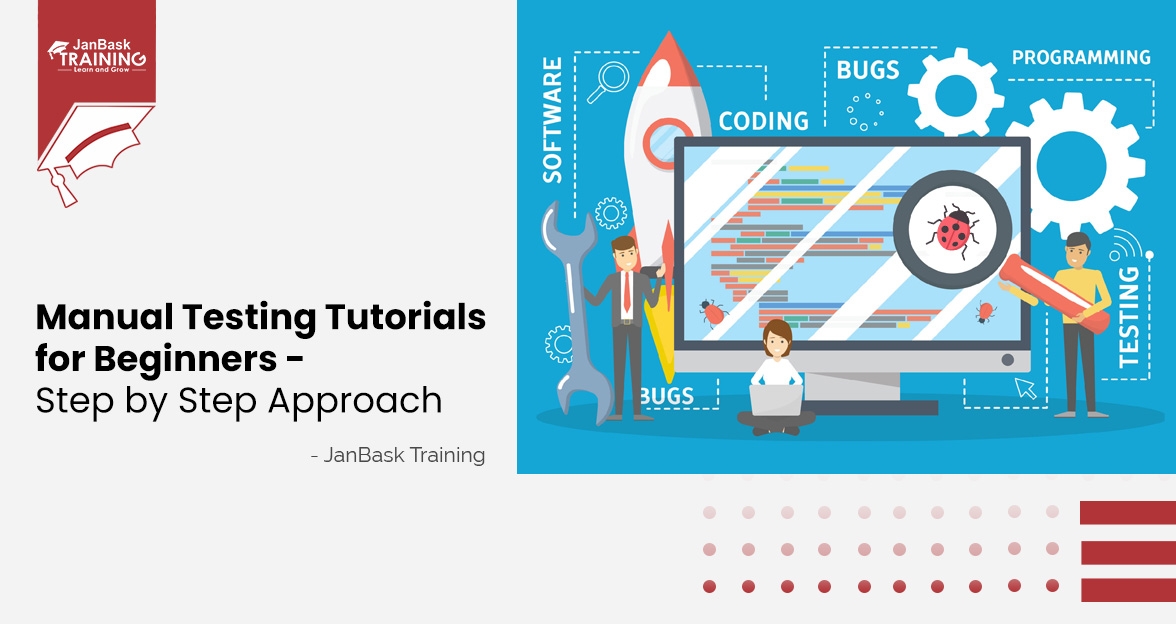Introduction
Functional Testing is a popular type of testing that verifies different functions of a software application that operates in conformance with requirements specification. It is majorly based on the black box testing technique, and it does not focus on the source code of the application.
The different functionalities of a system are tested by providing appropriate inputs, verifying the outputs and then comparing the actual results with the expected outcomes. This testing majorly involves User Interface, APIs, databases, security controls, client/server application functionality of an application under test. Functional Testing is performed either manually or can be automated.
To enhance your knowledge of Software Testing, join our QA Certification & Training Program. We offer a comprehensive course that covers all aspects of quality assurance. Learn from experienced instructors and get hands-on training. Get certified and land a high-paying job in the quality assurance field.
Let us discuss the objectives of functional testing and why you should choose it.
Why choose Functional Testing?
The major objective of Functional Testing is to check the functionalities of a software system. It majorly focuses on the following areas:
- Main Functions: This testing checks the main functions of an application.
- Usability: It involves the basic usability testing of the system. It checks either a user can navigate freely through screens without any issues.
- Accessibility: It focuses on the system accessibility for the user.
- Error logs: Functional testing is used to check different error conditions. It also checks either error messages are displayed properly or not.
How to perform Functional Testing?
There must be something to verify the acceptable behavior of an application. Functional Testing is a document that defines what is permitted by the user, and what is not. Sometimes, it entails the actual business scenarios to be validated. Functional testing is usually performed in two common steps:
- When testing is done based on functional requirements, it contains all the functional specifications that form the basis of tests to be conducted.
- When testing is done based on scenarios, it contains information about the system of how the business perspective will perceive it.
Testing and quality are major parts of the SDLC process, and we should be aware of all type of testing even if we are not directly involved with the testing regularly. The scope of testing is wider like an ocean, and a team of quality testers is required to give the right direction to an application.
If you are just starting your career in testing, it is recommended to go through a professional QA Testing Certification Course. It will help you learn the basics and become familiar with the advanced knowledge as well.
QA Software Testing Training
- Detailed Coverage
- Best-in-class Content
- Prepared by Industry leaders
- Latest Technology Covered
To check the functionality of a software application, the following steps should be followed:
- Understand the software app requirements and Identify the test cases for a software application.
- Identify the test data to use as input.
- Now calculate the final output with the selected input values.
- Execute the test cases build for the software application.
- In the last step, you should compare the actual and expected outputs together.
Different Types of Functional Testing
Functional Testing can be divided into multiple categories based on the scenario, and most popular ones are discussed below.
1). Unit Testing
Unit testing is performed by a developer to check different units of code that are either related or non-related to achieve a particular functionality. The process starts with writing unit test cases that would call methods in each unit and validate them when the required parameters are passed and returns the value as expected. Code coverage is an important functionality of unit testing where test cases should cover the following:
2). Sanity Testing
Testing that makes sure that all major components of a software application are working perfectly is termed as sanity testing. It is usually performed after a smoke test.
3). Smoke testing
Testing that is done once and the complete build is released to ensure the stability is called the smoke testing. The other name for smoke testing is to build verification testing.
4). Regression Testing
The regression testing is done to make sure that new code, enhancements, and bug fixes will not break the existing functionality of an application. For this purpose, you should write the test cases to check the functional ability of an application and make sure that it is stable.
5). Integration Testing
When we integrate multiple modules that are working great independently but not able to coordinate well when integrated together, this validation is termed as the integration testing. The integration testing is useful when you want to check all modules together how they communicate with each other. If there are any issues, they can be resolved immediately.
Further, you can explore various QA Testing blogs available on the JanBask Training which can increase your knowledge and answer your queries related to QA.
6). Beta/Usability Testing
When the product is exposed to customers in a production like an environment, and they test the product on different parameters in terms of usability, it is called the Beta testing. It is common these days if you need genuine feedback for the product. It is similar to the User Acceptance testing in most of the parameters.
You may understand different types of functional testing with the help of this flow chart.
7). System Testing
System testing is done on the whole system to make sure it is working as expected when all components are integrated and tested.
8). End to End Testing
It is performed to verify the functionality of a product when you are done with the system testing. It focuses on functional and non-functional requirements.
Entry/Exit Criteria for Functional Testing
Entry Criteria:
- The requirement specifications document is well defined and approved in advance.
- Test cases are generated by the testers.
- Test data has been created by programmers.
- The testing environment is ready to verify the different functionalities of a product.
- The tools are available to automate the test script when required.
- Application is developed either complete or partially and ready for the testing.
Exit Criteria:
- There are functional test cases whose execution should be completed.
- There are no open critical bugs.
- The reported bugs are acknowledged already.
Learn QA Software Testing in the Easiest Way
- Learn from the videos
- Learn anytime anywhere
- Pocket-friendly mode of learning
- Complimentary eBook available
Get the basic knowledge of Regression Testing by checking out our guide on Regression Testing Tutorial for Beginners.
Approaches for Writing Functional Tests
There are different approaches used for writing functional test cases in software engineering. Here is the skeleton of a test case how it should look like. A skeleton majorly consists of four parts, test summary, prerequisites, test steps, and expected results.
Approaching each test case by the programmer is time-consuming and impossible as well. Therefore, the QA team helps to strategize and optimize techniques on how to approach the testing. Let us understand the concept of Functional Testing with the help of an example.
Consider an online HRMS portal system where employees login with user account ID and password. There are two text fields where you have to add the credentials and two buttons, Login, and Cancel. If credentials are verified, it will take you to the HRMS login page, if credentials are not right then it will show some error.
There are special conditions for creating a User ID and the password. These two text fields are mandatory and should not be left blank. You cannot use special characters for user ID but allows adding special characters in Passwords. Programmers set these instructions and then they are validated by the testers using different Login attempts. 
The basic approach to test this scenario is divided into two broad categories:
- Positive Testing
- Negative Testing
Of course, each of the categories has its own subsections that should be carried out one by one. Positive testing means happy paths that are followed to test the basic requirements of a product that is vital to customer usage.
Negative Testing ensures that the product behaves properly when it is exposed to unexpected data. Let us understand the structure of Functional Testing using a flow chart below.
Think of taking this free, 2-minute QA Testing quiz to see how much you know about the testing field and to keep up with new developments.
Functional Testing Techniques

A). End-user Based Testing
A system can have different components that are coupled together to achieve the user scenario. In this example, the customer scenario includes tasks like HRMS application loading, data validation, credentials verification, home page navigation, performing actions, and logging out of the system. This workflow should work without errors in the business scenario. A few practical examples are given below.
|
S. No.
|
Test Case Summary
|
Pre-requisites
|
Test Case Data
|
Expected outcomes
|
|
1
|
A valid user with full privileges
|
- The user account should exist
- User should have full privileges
|
- The user adds account credentials.
- User has the permission to modify account himself.
- He will make the changes and saves them.
- He logs out from the account.
|
- User is logged to the home page.
- An edit screen appears to make changes.
- Save the account details.
- User is redirected to the Login Page
|
|
2
|
Another valid user without full privileges
|
- The user account should exist.
- User should have limited privileges
|
- The user adds account credentials.
- User has the permission to modify selected fields of an account.
- He will make the changes to selected fields and saves them.
- He logs out from the account.
|
- User is logged to the home page.
- An edit screen appears to make changes to selected fields.
- Save the account details.
- User is redirected to the Login Page
|
This is the basic example to make your ground skills stronger. So, we have used basic tests here.
Want to check insights? Here is a guide post on the Difference Between Smoke And Sanity Testing!
B). Equivalence Tests
In this type of testing, data is segregated into multiple partitions called equivalence data classes. Data for each partition should behave the same way, and only one condition should be tested here. If one particular condition does not work, then no condition will work further.
C). Boundary Value Tests
It applies data limits to an application and validates how it behaves. First, you should apply input values beyond boundary values, and it is considered a part of negative testing. You should know how to set the boundary limits and write test cases for boundary value analysis.
D). Decision-based Tests
These tests are centered around the ideology for possible outcomes from the system when a particular condition is met. For the given example, the following decision-based test cases can be derived immediately:
- If wrong credentials are added, it will ask you to reload the Login Page.
- If the user adds right credentials, then it should take you to the UI.
- If the user adds right credentials but wants to cancel Login, then it should not take the user to UI and reload the Login Page.
E). Alternate Flow Tests
Alternate path tests are written to validate all possible ways that exist other than the main flow to accomplish one function.
F). Ad-hoc Tests
When most of the bugs are identified and tested through the above techniques, ad-hoc tests are an excellent choice to uncover necessary discrepancies observed earlier. These tests are performed to check either system behaves gracefully or not. For the given example, a sample test case can be driven as below.
A user trying to log in but admin deleted the account when performing operations; it would be interesting knowing how to handle this issue gracefully.
To develop your QA skills and get a lucrative career in this field, collaborate and learn in the JanBask Software Testing community with other QA professionals.
How to compare Functional and Non-Functional Testing?
Functional Testing:
- It is performed using the functional specifications provided by the client and verify the system against functional requirements.
- Functional testing is performed at the initial level.
- You can perform this testing manually or use tools to automate this testing.
- Business requirements are the inputs for functional testing.
- Functional testing describes what the product does.
- Performing functional testing is easy.
- The most common types of functional testing can be given as:

Non-Functional Testing
- It is performed to check reliability, scalability, and non-functional aspects of the software system.
- Non-functional testing is performed, once the functional testing is complete.
- Mostly tools are used for non-functional testing.
- Performance parameters are inputs for non-functional testing like speed, scalability, etc.
- It describes how the product works.
- It is tough as compared to functional testing.
- The most common examples of Non-functional testing are

Also, if you are looking to increase domain knowledge. Check the basic unique testing guide to explore more here – Unit Testing Tutorial Guide for Beginners!
QA Software Testing Training
- No cost for a Demo Class
- Industry Expert as your Trainer
- Available as per your schedule
- Customer Support Available
Functional Test Automation – How to automate the functional tests?
The automated testing reduces the overall efforts, time, bug slippage, etc. and the efficiency is increased. However, everything cannot be automated, and you have to workout on test cases that you want to automate. For this purpose, you should find the right set of test cases that can be automated with functional testing tools.
Automating functional cases have drawbacks as well when several test cases are regressed again, and again then the developer may face issues in committing changes to the code. Many times, the most potential bugs are escaped because of lack of test coverage in a particular function. The automated functional testing may fail because of several reasons like a tester, environment, delivery of wrong functions, time constraints, etc.
When a dedicated team of experts works on each test cycle, defects may get missed. The best idea is automating the test cycle and realize a significant improvement in the efficiency of the test process and the test cases coverage. Automation is a replacement of manual efforts. Still, a mix of two always helps in adding the desired quality to software projects.
Check out the Top Performance Testing Tools when you are just starting your career in software testing.
What are the Automation Considerations?
- You should always select the right set of automation tools. There are plenty of tools available in the market and choosing the right automation tool can be a challenge here. You should always focus on project requirements first and decide on the automation tools accordingly.
- You should select the tool that is easy to use, and your QA team is also familiar with the tool.
- The tool can be used across different testing environments. You may create scripts on one platform and use them on another. So always decide on the testing tool accordingly.
- The tool must have all the features you need. For example, if you don’t know the scripting language, then the tool should do it for you. Further, if you don’t know automated tests building, logging, reporting, etc. then the tool should do it for you.
- The tool should be able to support the reusability of test cases for UI changes.
- The most common choice for automated functional testing is Selenium mostly. There are more choices too depends on requirements, user-friendly interface, and your budget. Another example is TestProject.io, a community-powered and cloud-based automation platform for mobile, web, and API testing. This can help testers ensure quality high-speed testing that works well with open-source frameworks. Other few examples are

How to choose test cases?
Always choose the right set of test cases to automate functional testing. If there are some test cases that require setup or configurations during test execution, then these should not be automated by programmers or testers. Therefore, you may automate tests in the following conditions:
- Choose tests that you want to run repeatedly.
- P1, P2 tests that demand a lot of efforts and time.
- Run tests with different data.
- Tests that are more prone to errors.
- Tests that you want to run in different environments.
Automation is generally imposed on the QA team, and there is no dedicated staff for this purpose in most organizations. Every member has a different experience, skills level, interest levels, and bandwidth to support the automation. Few are good at manual testing while others may good at automated test cases.
In this situation, it is always good to pick members with the right skills and knowledge in automation. Dedicated team for automation testing has mixed knowledge generally, and they are comfortable in writing test cases manually as well.
Note: To Learn more about Sanity Testing, check out this comprehensive blog on The Difference Between Smoke And Sanity Testing .
Conclusion
This tutorial has comprehensively discussed everything that you need to know about functional testing, right from the basics. Functional testing is one of the important testing aspects that verifies the functionality of a product and focuses on the most important aspects of an application.
To know more on Functional Testing and how to perform it practically, you may join the QA Training & Certification course now and expand your current testing skills and knowledge base.
Introduction
Testing Vs. Different Technologies
Interview
QA Testing Course
Upcoming Batches
Trending Courses
Cyber Security
- Introduction to cybersecurity
- Cryptography and Secure Communication
- Cloud Computing Architectural Framework
- Security Architectures and Models
Upcoming Class
7 days 25 Jul 2025
QA
- Introduction and Software Testing
- Software Test Life Cycle
- Automation Testing and API Testing
- Selenium framework development using Testing
Upcoming Class
-0 day 18 Jul 2025
Salesforce
- Salesforce Configuration Introduction
- Security & Automation Process
- Sales & Service Cloud
- Apex Programming, SOQL & SOSL
Upcoming Class
5 days 23 Jul 2025
Business Analyst
- BA & Stakeholders Overview
- BPMN, Requirement Elicitation
- BA Tools & Design Documents
- Enterprise Analysis, Agile & Scrum
Upcoming Class
7 days 25 Jul 2025
MS SQL Server
- Introduction & Database Query
- Programming, Indexes & System Functions
- SSIS Package Development Procedures
- SSRS Report Design
Upcoming Class
7 days 25 Jul 2025
Data Science
- Data Science Introduction
- Hadoop and Spark Overview
- Python & Intro to R Programming
- Machine Learning
Upcoming Class
-0 day 18 Jul 2025
DevOps
- Intro to DevOps
- GIT and Maven
- Jenkins & Ansible
- Docker and Cloud Computing
Upcoming Class
1 day 19 Jul 2025
Hadoop
- Architecture, HDFS & MapReduce
- Unix Shell & Apache Pig Installation
- HIVE Installation & User-Defined Functions
- SQOOP & Hbase Installation
Upcoming Class
-0 day 18 Jul 2025
Python
- Features of Python
- Python Editors and IDEs
- Data types and Variables
- Python File Operation
Upcoming Class
7 days 25 Jul 2025
Artificial Intelligence
- Components of AI
- Categories of Machine Learning
- Recurrent Neural Networks
- Recurrent Neural Networks
Upcoming Class
-0 day 18 Jul 2025
Machine Learning
- Introduction to Machine Learning & Python
- Machine Learning: Supervised Learning
- Machine Learning: Unsupervised Learning
Upcoming Class
7 days 25 Jul 2025
Tableau
- Introduction to Tableau Desktop
- Data Transformation Methods
- Configuring tableau server
- Integration with R & Hadoop
Upcoming Class
-0 day 18 Jul 2025























